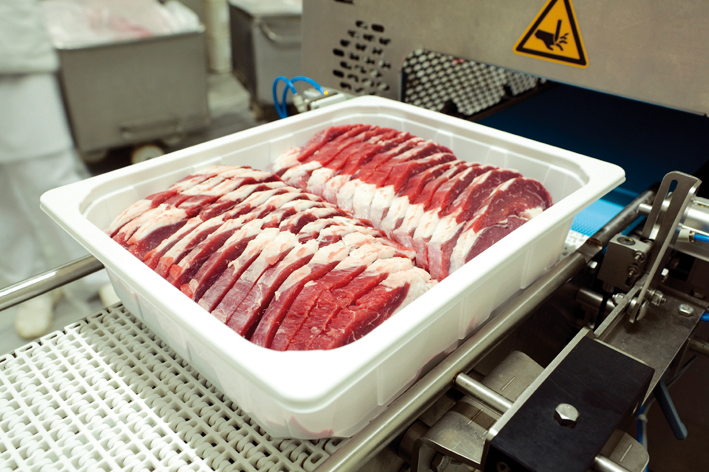Modified Atmosphere Packaging of Fresh Meat

Packaging fresh meat such as beef, pork and poultry in modified atmosphere packaging (MAP) presents an interesting challenge because of competing factors. The type of bacteria that tend to cause spoilage in meat are called aerobic bacteria – they need oxygen to survive. Consequently a low-oxygen atmosphere would seem to be desirable. However, for meat products, particularly red meat such as beef, one of the main problems of storage is ensuring that the meat retains its attractive red colour: in the open air meat tends to turn brown.
The colour of fresh meat is largely determined by the protein myoglobin, which is present in the tissue. Myoglobin itself is purple, but can react with oxygen to create two other pigmented forms, oxymyoglobin, which is red, and the brown metmyoglobin. In air, the concentration of oxygen is at a level that favours the formation of metmyoglobin, turning the meat brown. However, under much higher concentrations of oxygen, the deep red oxymyoglobin is more likely to be produced. So with the appropriate MAP mixture – typically between 60 and 80 per cent oxygen – fresh meat will retain its appetising colour, with red meat such as beef needing a higher oxygen level than less vividly coloured meat such as pork. So where does this leave the bacteria? Fortunately the growth of these aerobic bacteria can be significantly inhibited by the gas carbon dioxide. So if the remainder of the gas in the mixture is carbon dioxide – say 20 per cent – this will stall the growth of microbes that spoil fresh meat, and so both objectives, attractive appearance and a slow rate of spoilage, can be achieved.

Using the correct modified atmosphere packaging conditions, shelf life of red meat can typically be increased from around two to four days to between five and eight days under refrigeration, while that of poultry can be increased from 4-7 days to 16-21 days.
The colour of fresh meat is largely determined by the protein myoglobin, which is present in the tissue. Myoglobin itself is purple, but can react with oxygen to create two other pigmented forms, oxymyoglobin, which is red, and the brown metmyoglobin. In air, the concentration of oxygen is at a level that favours the formation of metmyoglobin, turning the meat brown. However, under much higher concentrations of oxygen, the deep red oxymyoglobin is more likely to be produced. So with the appropriate MAP mixture – typically between 60 and 80 per cent oxygen – fresh meat will retain its appetising colour, with red meat such as beef needing a higher oxygen level than less vividly coloured meat such as pork. So where does this leave the bacteria? Fortunately the growth of these aerobic bacteria can be significantly inhibited by the gas carbon dioxide. So if the remainder of the gas in the mixture is carbon dioxide – say 20 per cent – this will stall the growth of microbes that spoil fresh meat, and so both objectives, attractive appearance and a slow rate of spoilage, can be achieved.
Using the correct modified atmosphere packaging conditions, shelf life of red meat can typically be increased from around two to four days to between five and eight days under refrigeration, while that of poultry can be increased from 4-7 days to 16-21 days.




